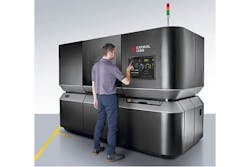XJet printer uses nanoparticles to make parts
Carmel 700 and Carmel 1400 These new 3-D printers from XJet feature inkjet print heads that deposit a liquid from a cartridge. Once the liquid falls onto the heated bed, it evaporates, leaving behind nanoparticles that bond to each other. The part is then moved to a sintering oven, where it hardens and support material is removed. XJet currently supplies cartridges containing ceramics; eventually, it plans to roll out metal materials for the printers. Injection mold components made with the printers are especially appropriate for small- to medium-sized production runs.
What's new? The Carmel-series printers, which made their U.S. debut last month, when the Youngstown Business Incubator installed a Carmel 1400, shown in photo, at its facility in Ohio.
Benefits The ability to produce mold components that feature complex geometries and fast cooling, with no need for debinding. With their nanoparticle technology, the printers can produce near-net-shape parts that exhibit very fine details and a high degree of accuracy in all directions. Using the printers, operators can produce sophisticated conformal cooling channels.
XJet Ltd., 972-8-9314620, Rehovot, Israel, www.xjet3d.com

